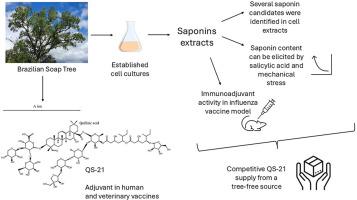Sourcing the vaccine adjuvant QS-21 and related saponins from cell cultures of Quillaja lancifolia (Brazilian soap tree)
IF 3.8
Q2 BIOTECHNOLOGY & APPLIED MICROBIOLOGY
引用次数: 0
Abstract
Soapbark tree saponins, notably QS-21, are highly required as adjuvants in commercial human and veterinary vaccines. Current industrial sources of these specialized metabolites rely on the bark of adult trees, posing challenges in terms of supply speed and sustainability. To address this matter, cell cultures of Quillaja lancifolia (Brazilian soap tree) were evaluated as a new source of immunoadjuvant saponins. Cell cultures were successfully established, characterized, and elicited. Saponin accumulation followed biomass increase. Carbon source modulated saponin profiles. Immunoadjuvant activity of cell culture-derived saponin aqueous extract was confirmed in murine model of influenza vaccine. The presence of QS-21 in cell cultures was verified by liquid chromatography and mass spectrometry. QS-21 concentration ranged from 0.01 to 0.1 % of the unelicited dry mass. A three-fold increase in QS-21 concentration was achieved by elicitation with salicylic acid. This is the first report on the production of QS-21 in cell cultures of Q. lancifolia and one of the top yields registered to date from a fully defined tree-free source for the genus. These cell cultures represent a new sustainable source of this high value complex triterpene in increasing demand by the vaccine industry.

从巴西皂树的细胞培养物中提取疫苗佐剂QS-21及相关皂苷
皂皮树皂苷,特别是QS-21,是高度需要作为佐剂的商业人用和兽用疫苗。目前这些特殊代谢物的工业来源依赖于成年树的树皮,在供应速度和可持续性方面提出了挑战。为了解决这个问题,巴西皂树(Quillaja lancifolia)的细胞培养被评价为免疫佐剂皂苷的新来源。细胞培养成功建立、鉴定和诱导。皂苷积累随生物量增加而增加。碳源调制皂素谱。在流感疫苗小鼠模型上证实了细胞培养皂苷水提物的免疫佐剂活性。通过液相色谱和质谱分析证实了QS-21在细胞培养中的存在。QS-21浓度范围为未提取干质量的0.01 ~ 0.1%。通过水杨酸激发,QS-21的浓度增加了三倍。这是首次报道在紫杉树细胞培养中产生QS-21,也是迄今为止在完全确定的无树来源中记录到的最高产量之一。在疫苗工业日益增长的需求中,这些细胞培养物代表了这种高价值复合物三萜的新的可持续来源。
本文章由计算机程序翻译,如有差异,请以英文原文为准。
求助全文
约1分钟内获得全文
求助全文
来源期刊

Biocatalysis and agricultural biotechnology
Agricultural and Biological Sciences-Agronomy and Crop Science
CiteScore
7.70
自引率
2.50%
发文量
308
审稿时长
48 days
期刊介绍:
Biocatalysis and Agricultural Biotechnology is the official journal of the International Society of Biocatalysis and Agricultural Biotechnology (ISBAB). The journal publishes high quality articles especially in the science and technology of biocatalysis, bioprocesses, agricultural biotechnology, biomedical biotechnology, and, if appropriate, from other related areas of biotechnology. The journal will publish peer-reviewed basic and applied research papers, authoritative reviews, and feature articles. The scope of the journal encompasses the research, industrial, and commercial aspects of biotechnology, including the areas of: biocatalysis; bioprocesses; food and agriculture; genetic engineering; molecular biology; healthcare and pharmaceuticals; biofuels; genomics; nanotechnology; environment and biodiversity; and bioremediation.
 求助内容:
求助内容: 应助结果提醒方式:
应助结果提醒方式:


